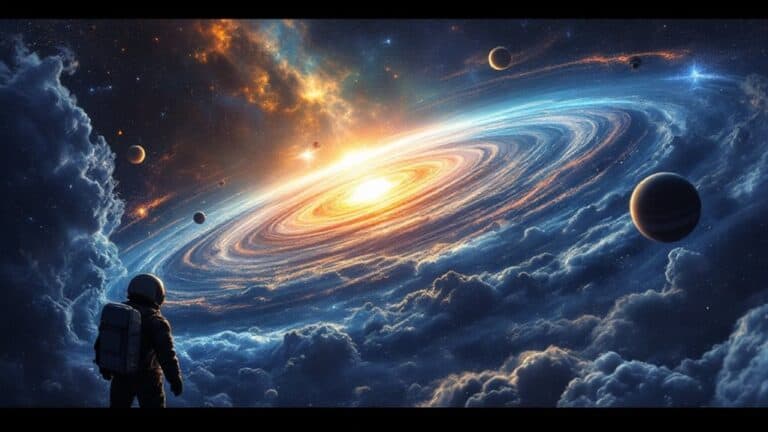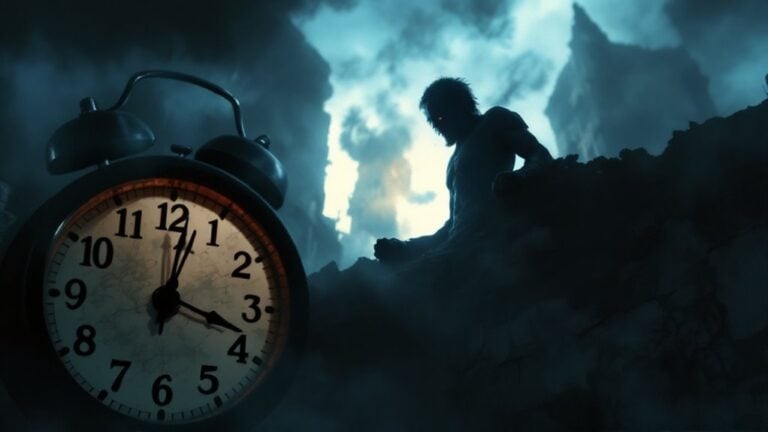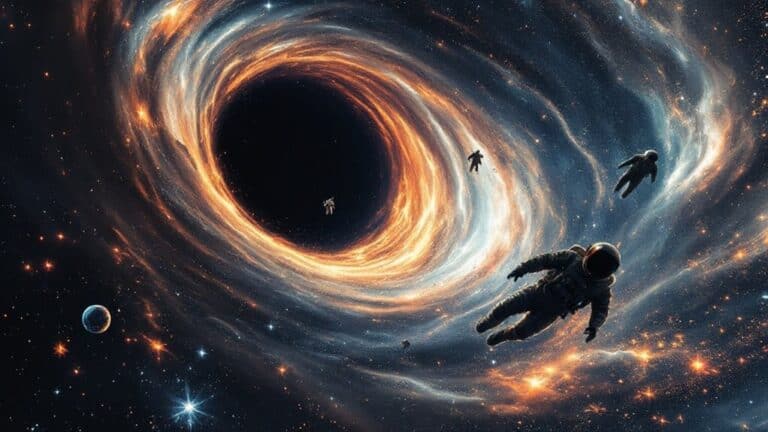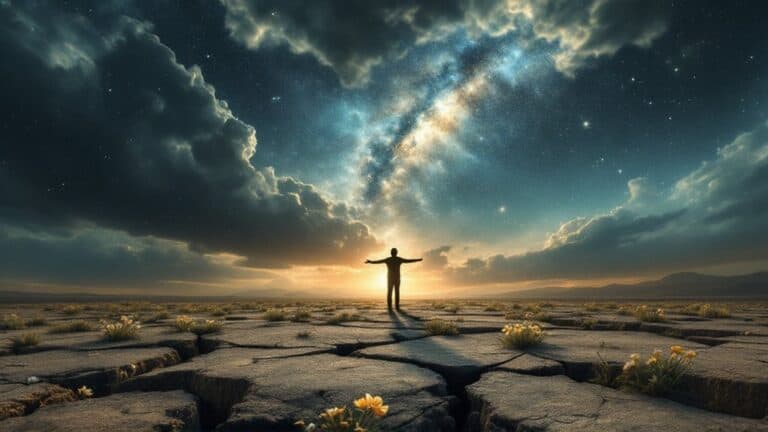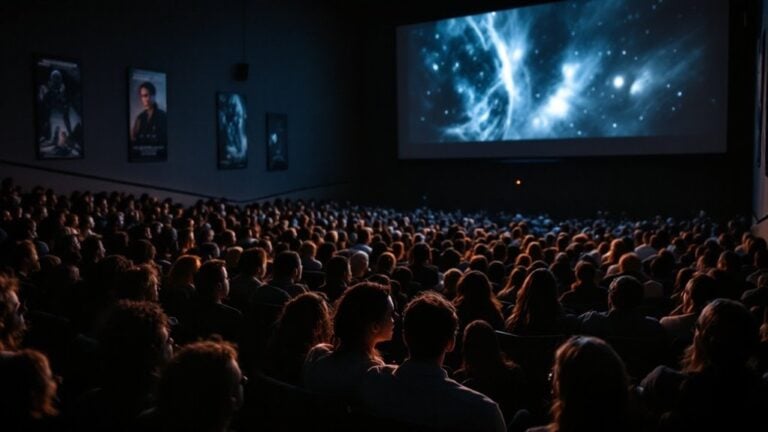Behind the Scenes: Creating Interstellar’s Iconic Black Hole Scene
Creating the iconic black hole scene in “Interstellar” involved a groundbreaking blend of science and artistry, drawing on real astrophysics, particularly general relativity. You’ll find that physicist Kip Thorne collaborated closely with the visual effects team at DNEG to craft an accurate portrayal of Gargantua, achieving stunning visual effects through the innovative Double Negative Gravitational Renderer. With simulations that took up to 100 hours, they captured light bending around the black hole, enhancing both the cinematic experience and scientific understanding. This commitment to precision not only redefined cinematic science but also inspired renewed interest in black hole research and visualization. There’s much more to explore in this fascinating intersection of art and science.
Table of Contents
Key Takeaways
- The black hole scene was based on real astrophysical principles, particularly general relativity, and featured the spinning black hole Gargantua.
- Collaboration between physicist Kip Thorne and visual artists ensured an accurate portrayal of black holes, setting new standards for scientific representation in film.
- The Double Negative Gravitational Renderer (DNGR) was developed to accurately simulate light bending and gravitational lensing around the black hole.
- Extensive computational resources were used, with rendering times reaching up to 100 hours to achieve ultra-high definition visuals.
- Innovative visual effects techniques, including light painting and practical effects, enhanced the immersive experience and contributed to the film’s legacy in science and cinema.
Science Behind the Black Hole
In “Interstellar,” the science behind the iconic black hole scene is rooted in real astrophysical principles. The filmmakers, led by the talented team at Double Negative and physicist Kip Thorne, dove deep into black hole physics to create a visually stunning and scientifically accurate portrayal.
They simulated how light bends around the rapidly spinning black hole, Gargantua, which spins at an astonishing 99.8% of the speed of light. This rapid spin generates significant spacetime distortion, warping the very fabric of reality around it. The visual effects team utilized a new computer code to ensure accurate representations of Gargantua, enhancing the film’s authenticity. Additionally, their work led to the first computation of caustics effects near a black hole, providing groundbreaking insights into the phenomena.
As you watch the film, you might notice the peculiar optical effects, like caustics, where the gravitational field distorts light beams, creating multiple images of distant stars. These elements not only captivate your imagination but also ground the story in the principles of general relativity. DNEG’s collaboration with scientists brought a new level of precision to visualizing these effects, further enriching the cinematic experience.
The strong gravitational field creates an event horizon, where time dilates, slowing down dramatically as you approach.
Through meticulous simulations, the team produced smooth imagery that reflects the complexity of black hole environments, merging art and science in a way that invites you to ponder the mysteries of the universe.
You can feel the awe of discovery, as this film sparks curiosity about the cosmos and our place within it.
Visual Effects Techniques
The visual effects techniques employed in “Interstellar” blend practical effects with cutting-edge CGI to create a breathtaking representation of space phenomena.
You might be amazed to learn that Joey Shanks of Shanks FX utilized light painting techniques to craft the film’s iconic black hole, using in-camera visual effects enhanced by post-production tweaks in After Effects. This careful combination of practical effects and digital artistry allowed for a striking cosmic environment, incorporating materials like glass and food coloring. The original black hole design was not only groundbreaking for the film but also for the cinematic and scientific communities. Furthermore, the film’s production emphasized practical effects to ground its fantastical elements in reality. This focus on realistic lighting and environments helped enhance viewer immersion and connection to the visuals.
At the same time, the team developed the Double Negative Gravitational Renderer (DNGR), an innovative computer code that mapped millions of light beams through the black hole’s warped spacetime.
This CGI integration guaranteed that the black hole, Gargantua, and its accretion disk appeared both smooth and scientifically accurate. They even traced distorted light paths to eliminate flickering, creating visuals that felt incredibly lifelike.
Collaboration and Impact

Throughout the creation of “Interstellar,” a unique collaboration between theoretical physicist Kip Thorne and visual effects company Double Negative (DNEG) redefined how science and cinema can intersect. By combining Thorne’s deep understanding of black hole behavior with DNEG’s innovative visual techniques, they achieved a stunning representation that was rooted in scientific accuracy. This interdisciplinary collaboration brought together experts in physics, computer science, and visual arts, proving that when diverse minds unite, extraordinary breakthroughs emerge. Notably, the collaboration resulted in some of the most accurate black hole visualizations in film history, showcasing the groundbreaking ray tracing technology used to simulate light behavior around Gargantua. Additionally, the film aimed to represent complex scientific concepts for a broad audience, drawing inspiration from Carl Sagan’s contributions.
Oliver James, DNEG’s chief scientist, played a pivotal role in this partnership, ensuring that the visual effects accurately reflected complex scientific principles. Their work not only enhanced the film’s storytelling but also contributed to the field of astrophysics itself, with findings on gravitational lensing leading to published studies.
This collaboration set a new standard for accuracy in cinematic visuals and inspired ongoing research into black holes.
As you reflect on this project, you can appreciate how it illustrates the power of unlikely partnerships. By bridging gaps between disciplines, it fosters not only a greater understanding of the universe but also a sense of belonging to a community that values innovation and creativity.
Innovative Approaches
Using groundbreaking techniques, the team at Double Negative (DNEG) pushed the boundaries of visual effects to create a stunning representation of a black hole.
They developed the Double Negative Gravitational Renderer (DnS), an innovative rendering tool that traced millions of light beams through warped spacetime, capturing the intricate dance of light around a black hole.
By employing ray tracing and custom algorithms, they simulated gravitational lensing, accurately depicting the distortion of starlight, while ensuring high-resolution images overcame previous flickering issues.
In addition to these advanced digital methods, practical effects played a significant role. Joey Shanks used light painting techniques and everyday items like glass and paper towels to craft a tangible version of the cosmic phenomenon. This blend of innovative rendering and practical effects created a visceral experience, making the black hole feel both real and relatable. Furthermore, the black hole effect was achieved using in-camera elements and post-production techniques, showcasing a unique approach to visual storytelling.
Behind the Scenes Insights

Creating the breathtaking black hole scene in Interstellar wasn’t just about digital wizardry; it involved a unique partnership between scientists and visual artists. You see, physicist Kip Thorne collaborated closely with the visual effects team, ensuring that every detail of the black hole was grounded in scientific accuracy. This collaboration birthed the first realistic portrayal of a black hole in a Hollywood film, blending creative storytelling with cinematic realism in ways that captivated audiences. The film’s black hole scene is a visual highlight that showcases the first realistic portrayal of a black hole in Hollywood.
The challenges were immense, from high rendering times of up to 100 hours to accurately modeling gravitational lensing and light behavior. DNEG’s Chief Scientist, Oliver James, led the charge with custom software that brought these complex concepts to life. This software was specifically designed to visualize gravitational lensing in a way that had never been done before. The collaboration with Kip Thorne not only resulted in groundbreaking visuals but also established a high standard for future representations of space phenomena.
Working alongside VFX Supervisor Paul Franklin, they transformed Thorne’s equations into stunning visuals that not only entertained but educated viewers about the mysteries of astrophysics.
Interstellar’s visuals set a new standard for scientific accuracy in cinema, connecting audiences with the wonders of science. Their commitment to authenticity resonates deeply, showing how art can illuminate complex ideas while forging a sense of belonging in the conversation about our universe.
Production Details
Often, the production of Interstellar’s black hole scene required innovative techniques to achieve its groundbreaking visuals. The team developed a custom renderer called the Double Negative Gravitational Renderer (DNGR), which mapped the paths of millions of light beams as they navigated through the black hole’s warped spacetime. This effort epitomized their dedication to visual storytelling, pushing the boundaries of what CGI could achieve.
The collaboration with theoretical physicist Kip Thorne guaranteed scientific accuracy, allowing the filmmakers to create a realistic, three-dimensional representation of a black hole, complete with an accretion disk. High-resolution simulations brought unparalleled clarity to the wormhole and black hole scenes, allowing audiences to immerse themselves in this cosmic wonder. Additionally, the use of gravitational lensing techniques further enhanced the visual effects, showcasing the unique distortions of light near the black hole. This commitment to adherence to quantum physics was pivotal in ensuring that the black hole’s depiction was not only visually stunning but also grounded in scientific principles.
As the production timeline progressed, the team faced challenges, such as flickering caused by traditional rendering methods. By tracing distorted light paths, they crafted smooth, breathtaking images that left viewers in awe.
The meticulous attention to detail not only enhanced the film’s narrative but also contributed to real-world science, leading to published papers that reflected the fusion of art and science. This unique approach to visual storytelling solidified the black hole scene as a hallmark of cinematic achievement.
Challenges Faced by the Team

Managing the complexities of scientific accuracy posed significant challenges for the Interstellar team. You might find it fascinating that they’d to navigate numerous hurdles to create the iconic black hole scene.
Here’s a glimpse into some of those rendering challenges and computational obstacles:
- Traditional rendering methods fell short, as they assumed light traveled in straight paths.
- The team innovated with the Double Negative Gravitational Renderer (DNGR) to accurately portray light through warped space-time.
- They tackled the need for ultra-high definition visuals while eliminating artifacts, which meant each frame took around 100 hours to render.
- The complexity of gravitational lensing effects intensified the closer they got to the black hole, demanding more computational steps.
The team had to balance scientific rigor with cinematic appeal, working diligently to guarantee every aspect, from the accretion disk to the color grading, mirrored the realities of space-time.
As you explore the intricacies of their process, you’ll appreciate the dedication and creativity that transformed theoretical physics into breathtaking visuals, bringing a sense of wonder and connection to the audience.
Legacy of the Black Hole Scene
Transforming theoretical concepts into stunning visuals, the black hole scene in “Interstellar” has left a profound legacy in both science and cinema. This cinematic masterpiece not only captivated audiences but also sparked a renewed interest in black hole research.
The visual effects team‘s groundbreaking work led to published papers that detailed their methods, providing valuable insights into gravitational lensing and accretion disks. By setting new standards for realistic portrayals, “Interstellar” influenced future films and documentaries, emphasizing the importance of collaboration between artists and scientists.
The innovative software developed for the film, such as the Double Negative Gravitational Renderer, pushed the boundaries of visual effects in ways that continue to inspire filmmakers today.
Moreover, the film’s commitment to scientific accuracy educated a global audience about the complexities of black holes, creating a sense of belonging among those who share a passion for science.
As future observations refine our understanding of these cosmic phenomena, “Interstellar’s” contributions guarantee its cinematic legacy endures, reminding us that the intersection of art and science can illuminate the mysteries of the universe in ways we never thought possible.
Conclusion
In crafting the iconic black hole scene of *Interstellar*, the filmmakers didn’t just push technical boundaries; they also captured the profound human experience of grappling with the unknown. Their innovative techniques transformed complex science into stunning visuals, demonstrating that sometimes, you have to think outside the box to reach for the stars. This collaboration not only set a new standard in visual effects but also left an indelible mark on both cinema and our understanding of cosmic wonders.


